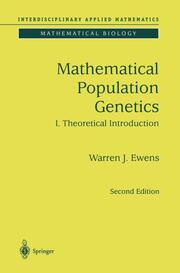-
Zusatztext
-
InhaltsangabeContents Preface Introduction 1 Historical Background 1.1 Biometricians, Saltationists and Mendelians 1.2 The Hardy-Weinberg Law 1.3 The Correlation Between Relatives 1.4 Evolution 1.4.1 The Deterministic Theory 1.4.2 NonRandomMating Populations 1.4.3 The Stochastic Theory 1.5 Evolved Genetic Phenomena 1.6 Modelling 1.7 Overall Evolutionary Theories 2 Technicalities and Generalizations 2.1 Introduction 2.2 Random Union of Gametes 2.3 Dioecious Populations 2.4 Multiple Alleles 2.5 Frequency-Dependent Selection 2.6 Fertility Selection 2.7 Continuous-Time Models 2.8 NonRandomMating Populations 2.9 The Fundamental Theorem of Natural Selection 2.10 Two Loci 2.11 Genetic Loads 2.12 Finite Markov Chains 3 Discrete Stochastic Models 3.1 Introduction 3.2 WrightFisher Model: Two Alleles 3.3 The Cannings (Exchangeable) Model: Two Alleles 3.4 Moran Models: Two Alleles 3.5 KAllele WrightFisher Models 3.6 Infinitely Many Alleles Models 3.6.1 Introduction 3.6.2 The Wright-Fisher In.nitely Many Alleles Model 3.6.3 The Cannings In.nitely Many Alleles Model 3.6.4 The Moran In.nitely Many Alleles Model 3.7 The Effective Population Size 3.8 Frequency-Dependent Selection 3.9 Two Loci 4 Diffusion Theory 4.1 Introduction 4.2 The Forward and Backward Kolmogorov Equations 4.3 Fixation Probabilities 4.4 Absorption Time Properties 4.5 The Stationary Distribution 4.6 Conditional Processes 4.7 Diffusion Theory 4.8 Multidimensional Processes 4.9 Time Reversibility 4.10 Expectations of Functions of Di.usion Variables 5 Applications of Diffusion Theory 5.1 Introduction 5.2 No Selection or Mutation 5.3 Selection 5.4 Selection: Absorption Time Properties 5.5 OneWay Mutation 5.6 TwoWay Mutation 5.7 Diffusion Approximations andBoundary Conditions 5.8 Random Environments 5.9 TimeReversal and Age Properties 5.10 MultiAllele Diffusion Processes 6 Two Loci 6.1 Introduction 6.2 Evolutionary Properties of Mean Fitness 6.3 Equilibrium Points 6.4 Special Models 6.5 Modifier Theory 6.6 TwoLocus Diffusion Processes 6.7 Associative Overdominance and Hitchhiking 6.8 The Evolutionary Advantage of Recombination 6.9 Summary 7 Many Loci 7.1 Introduction 7.2 Notation 7.3 The Random Mating Case 7.3.1 Linkage Disequilibrium, Means and Variances 7.3.2 Recurrence Relations for Gametic Frequencies 7.3.3 Components of Variance 7.3.4 Particular Models 7.4 NonRandom Mating 7.4.1 Introduction 7.4.2 Notation and Theory 7.4.3 Marginal Fitnesses and Average Effects 7.4.4 Implications 7.4.5 The Fundamental Theorem of Natural Selection 7.4.6 Optimality Principles 7.5 The Correlation Between Relatives 7.6 Summary 8 Further Considerations 8.1 Introduction 8.2 What is Fitness? 8.3 Sex Ratio 8.4 Geographical Structure 8.5 Age Structure 8.6 Ecological Considerations 8.7 Sociobiology 9 Molecular Population Genetics: Introduction 9.1 Introduction 9.2 Technical Comments 9.3 In.nitely Many Alleles Models: Population Properties 9.3.1 The Wright-Fisher Model 9.3.2 The Moran Model 9.4 In.nitely Many Sites Models: Population Properties 9.4.1 Introduction 9.4.2 The Wright-Fisher Model 9.4.3 The Moran Model 9.5 Sample Properties of In.nitely Many Alleles Models 9.5.1 Introduction 9.5.2 The Wright-Fisher Model 9.5.3 The Moran Model 9.6 Sample Properties of In.nitely Many Sites Models 9.6.1 Introduction 9.6.2 The Wright-Fisher Model 9.6.3 The Moran Model 9.7 Relation Between In.nitely Many Alleles and Infinitely Many Sites Models 9.8 Genetic Variation Within and Between
-
-
Kurztext
-
Population genetics occupies a central role in a number of important biological and social undertakings. It is fundamental to our understanding of evolutionary processes, of plant and animal breeding programs, and of various diseases of particular importance to mankind. This is the first of a planned two-volume work discussing the mathematical aspects of population genetics, with an emphasis on the evolutionary theory. This first volume draws heavily from the author's classic 1979 edition since the material in that edition may be taken, to a large extent, as introductory to the contemporary theory. It has been revised and expanded to include recent topics that follow naturally from the treatment in the earlier edition, e.g., the theory of molecular population genetics and coalescent theory. This book will appeal to graduate students and researchers interested in theoretical population genetics and evolution. Reviews of the first edition: Ewens book will be an important reference to anyone interested in the mathematical aspects of population genetics, not only to those actually doing it, but also to anyone trying to bridge the now substantial gap between theoretical and experimental population genetics. Woodrow Setzer, Quarterly Review of Biology, 1980 This book is an excellent combination of an introduction to population genetics theory for a mathematically sophisticated reader, together with a survey of current work in the field. Stanley Sawyer, SIAM Review, 1980
-
-
Schlagzeile
- 2nd edition
Detailansicht
Mathematical Population Genetics
Theoretical Introduction I, Interdisciplinary Applied Mathematics 27
ISBN/EAN: 9781441918987
Umbreit-Nr.: 1547439
Sprache:
Englisch
Umfang: xx, 418 S.
Format in cm:
Einband:
kartoniertes Buch
Erschienen am 29.11.2010
Auflage: 2/2004


